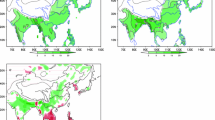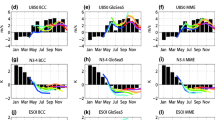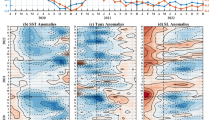Abstract
We explore the causes and predictability of extreme low minimum temperatures (Tmin) that occurred across northern and eastern Australia in September 2019. Historically, reduced Tmin is related to the occurrence of a positive Indian Ocean Dipole (IOD) and central Pacific El Niño. Positive IOD events tend to locate an anomalous anticyclone over the Great Australian Bight, therefore inducing cold advection across eastern Australia. Positive IOD and central Pacific El Niño also reduce cloud cover over northern and eastern Australia, thus enhancing radiative cooling at night-time. During September 2019, the IOD and central Pacific El Niño were strongly positive, and so the observed Tmin anomalies are well reconstructed based on their historical relationships with the IOD and central Pacific El Niño. This implies that September 2019 Tmin anomalies should have been predictable at least 1–2 months in advance. However, even at zero lead time the Bureau of Metereorolgy ACCESS-S1 seasonal prediction model failed to predict the anomalous anticyclone in the Bight and the cold anomalies in the east. Analysis of hindcasts for 1990–2012 indicates that the model's teleconnections from the IOD are systematically weaker than the observed, which likely stems from mean state biases in sea surface temperature and rainfall in the tropical Indian and western Pacific Oceans. Together with this weak IOD teleconnection, forecasts for earlier-than-observed onset of the negative Southern Annular Mode following the strong polar stratospheric warming that occurred in late August 2019 may have contributed to the Tmin forecast bust over Australia for September 2019.











Similar content being viewed by others
Availability of data and material
The JRA-55 reanalyses are available from https://rda.ucar.edu/. The Hurrell SST anayses are available from: https://climatedataguide.ucar.edu/climate-data/merged-hadley-noaaoi-sea-surface-temperature-sea-ice-concentration-hurrell-et-al-2008. The AWAP Australian temperature and rainfall analyses are available from the Australian Bureau of Meteorology: "Australian Gridded Climate Data (AGCD)/AWAP; v1.0.0 Snapshot (1900-01-01 to 2018-12-31)" (https://doi.org/10.4227/166/5a8647d1c23e0). The ACCESS-S1 hindcasts and real time prediction system are described in Hudson et al. (2017).
Code availability
The NCAR Command Language (NCL; http://www.ncl.ucar.edu) version 6.4.0 and IDL version 8.7.3 were used for data analysis and visualization of the results.
Notes
The term "central Pacific El Niño" is used in this study to describe an event whose maximum SST anomaly is found near the dateline. This will not necessarily correspond to a canonical El Niño whose maximum SST anomaly is found across the equatorial central to eastern Pacific.
Here we have used the Spearman rank correlation to relate the occurrences of days with Tmin < 2 and 0 °C to the monthly Tmin at each gridpoint because the relationship may not be linear although we assume the relationship between monthly Tmin and number of days below a threshold is monotonic (i.e., number of days below 2 and 0 °C increases with lower values of monthly mean Tmin).
The DMI derived from the HadISST data set (available at Climate Explorer) shows a strong positive trend since the 1960s, and consequently, the 2019 DMI was the highest on record since 1979 before removing the linear trend and the 2nd highest after removing the trend. For the consistency of the SST data for the DMI and the EMI, we computed our own DMI and EMI using the SST data described in Sect. 2. While the positive trend in the DMI is significantly stronger in the HadISST than in the data used in this study, the de-trended DMI of the HadISST is highly correlated with our de-trended DMI by 0.9.
The de-trended DMI and EMI are correlated by 0.3 in September, which is statistically significant at the 10% level, as assessed by a two-tailed Student-t test with 40 samples of 1979–2018. This moderate collinearity of the two indices is appropriately dealt with in multiple linear regression calculation. See Supplementary Information for the calculations of the total explained variance and regression coefficients.
The ratio of the correct forecasts for the occurrence of an event to the total number of forecasts.
The ratio of the incorrect forecasts for the occurrence of an event (i.e., forecasts for the occurrence which are not observed) to the total number of forecasts.
The SAM index in this study was obtained following Gong and Wang (1999)’s definition, which is the difference of normalised zonal-mean MSLP anomalies between 40° S and 65° S.
References
Ashok K, Behera SK, Rao SA et al (2007) El Niño Modoki and its possible teleconnection. J Geophys Res Ocean 112(C11007). https://doi.org/10.1029/2006JC003798
Bange MP, Milroy SP (2004) Impact of short-term exposure to cold night temperatures on early development of cotton (Gossypium hirsutum L.). Aust J Agric Res 55:655–664
Boer MM, Resco de Dios V, Bradstock RA (2020) Unprecedented burn area of Australian mega forest fires. Nat Climate Chang 10:171–172. https://doi.org/10.1038/s41558-020-0710-7
Cai W, van Rensch P, Cowan T, Hendon HH (2011) Teleconnection pathways of ENSO and the IOD and the mechanisms for impacts on Australian rainfall. J Climate 24:3910–3923. https://doi.org/10.1175/2011JCLI4129.1
Cowan T, Wheeler MC, Alves O et al (2019) Forecasting the extreme rainfall, low temperatures, and strong winds associated with the northern Queensland floods of February 2019. Weather Climate Extrem 26:100232
Crimp SJ, Gobbett D, Kokic P et al (2016) Recent seasonal and long-term changes in southern Australian frost occurrence. Clim Change 139:115–128. https://doi.org/10.1007/s10584-016-1763-5
Dee D, Uppala S, Simmons A et al (2011) The ERA—interim reanalysis: configuration and performance of the data assimilation system. Q J R Meteorol Soc 137:553–597. https://doi.org/10.1002/qj.828
Dittus AJ, Karoly DJ, Lewis SC, Alexander LV (2014) An investigation of some unexpected frost day increases in southern Australia. Aust Meteorol Ocean J 64:261–271
Frederiks TM, Christopher JT, Sutherland MW, Borrell AK (2015) Post-head-emergence frost in wheat and barley: defining the problem, assessing the damage, and identifying resistance. J Exp Bot 66:3487–3498. https://doi.org/10.1093/jxb/erv088
Gong D, Wang S (1999) Definition of Antarctic Oscillation index. Geophys Res Lett 26:459–462. https://doi.org/10.1029/1999GL900003
Grantz DA (1989) Effect of cool temperatures on photosynthesis and stomatal conductance in field-grown sugarcane in Hawaii. F Crop Res 22:143–155
Grose MR, Black M, Risbey JS et al (2018) Severe frosts in Western Australia in September 2016. Bull Am Meteorol Soc 99:S150–S154. https://doi.org/10.1175/BAMS-D-17-0088.1
Hatfield JL, Prueger JH (2015) Temperature extremes: effect on plant growth and development. Weather Climate Extrem 10:4–10. https://doi.org/10.1016/j.wace.2015.08.001
Hendon HH, Thompson DWJ, Wheeler MC (2007) Australian rainfall and surface temperature variations associated with the Southern Hemisphere Annular Mode. J Climate 20:2452–2467. https://doi.org/10.1175/JCLI4134.1
Hendon HH, Lim E, Wang G et al (2009) Prospects for predicting two flavors of El Niño. Geophys Res Lett 36(L19713). https://doi.org/10.1029/2009GL040100
Hendon HH, Lim E-P, Liu G (2012) The role of air-sea interaction for prediction of Australian summer monsoon rainfall. J Climate 25:1278–1290. https://doi.org/10.1175/JCLI-D-11-00125.1
Hendon HH, Lim E-P, Abhik S (2020) Impact of interannual ozone variations on the downward coupling of the 2002 southern hemisphere stratospheric warming. J Geophys Res Atmos 125(e2020JD032952). https://doi.org/10.1029/2020JD032952
Hudson D et al (2017) ACCESS-S1 The new Bureau of Meteorology multi-week to seasonal prediction system. J S Hemisph Earth Syst Sci 67:132–159. https://doi.org/10.22499/3.6703.001
Hurrell JW, Hack JJ, Shea D et al (2008) A new sea surface temperature and sea ice boundary dataset for the community atmosphere model. J Climate 21:5145–5153. https://doi.org/10.1175/2008JCLI2292.1
Jacobs BC, Pearson CJ (1999) Growth, development and yield of rice in response to cold temperature. J Agron Crop Sci 182:79–88
Jones D, Wang W, Fawcett R (2009) High-quality spatial climate data-sets for Australia. Aust Meteorol Oceanogr J 58:233–248
Kalma JD, Laughlin GP, Caprio JM, Hamer PJC (1992) The occurrence of frost: types, distribution and prediction. In: The bioclimatology of frost. Advances in bioclimatology, vol 2. Springer, Berlin
Kao HY, Yu JY (2009) Contrasting Eastern-Pacific and Central-Pacific types of ENSO. J Clim 22:615–632. https://doi.org/10.1175/2008JCLI2309.1
Keller M, Tarara JM, Mills LJ (2010) Spring temperatures alter reproductive development in grapevines. Aust J Grape Wine Res 16:445–454
Kobayashi S, Ota Y, Harada Y et al (2015) The JRA-55 reanalysis: general specifications and basic characteristics. J Meteorol Soc Japan Ser II 93:5–48. https://doi.org/10.2151/jmsj.2015-001
Kug J-S, Jin F-F, An S-I (2009) Two types of El Niño events: cold tongue El Niño and Warm Pool El Niño. J Clim 22:1499–1515. https://doi.org/10.1175/2008JCLI2624.1
Lim E, Hendon HH (2015) Understanding the contrast of Australian springtime rainfall of 1997 and 2002 in the frame of two flavors of El Niño. J Climate 28:2804–2822. https://doi.org/10.1175/JCLI-D-14-00582.1
Lim E, Hendon HH, Boschat G et al (2019) Australian hot and dry extremes induced by weakenings of the stratospheric polar vortex. Nat Geosci 12:896–901. https://doi.org/10.1038/s41561-019-0456-x
Lim E, Hendon HH, Butler AH et al (2020) The 2019 Antarctic sudden stratospheric warming. SPARC Newsl 54:10–13
Lim E, Hendon HH, Butler AH et al (2021) The 2019 Southern Hemisphere stratospheric polar vortex weakening and its impacts. Bull Am Meteorol Soc. https://doi.org/10.1175/BAMS-D-20-0112.1
MacLachlan C, Arribas A, Peterson KA et al (2015) Global seasonal forecast system version 5 (GloSea5): a high-resolution seasonal forecast system. Q J R Meteorol Soc 141:1072–1084. https://doi.org/10.1002/qj.2396
Marshall AG, Hudson D, Wheeler MC et al (2014) Intra-seasonal drivers of extreme heat over Australia in observations and POAMA-2. Climate Dyn 43:1915–1937. https://doi.org/10.1007/s00382-013-2016-1
McIntosh PC, Hendon HH (2018) Understanding Rossby wave trains forced by the Indian Ocean Dipole. Clim Dyn 50:2783–2798. https://doi.org/10.1007/s00382-017-3771-1
Pook MJ, Lisson S, Risbey J et al (2009) The autumn break for cropping in southeast Australia: trends, synoptic influences, and impacts on wheat yield. Int J Clim 29:2012–2026
Rao J, Garfinkel CI, White IP, Schwartz C (2020) The southern hemisphere sudden stratospheric warming in September 2019 and its predictions in S2S Models. J Geophys Res Atmos 125(e2020JD032723). https://doi.org/10.1029/2020JD032723
Rayner NAA, Parker DE, Horton EB, Folland CK, Alexander LV, Rowell DP, Kent EC, Kaplan A (2003) Global analyses of sea surface temperature, sea ice, and night marine air temperature since the late nineteenth century. J Geophys Res Atmos 108 (D14)
Rebbeck M, Lynch C, Hayman PT, Sadras V (2007) Delving of sandy surfaced soils reduces frost damage in wheat crops. Aust J Agric Res 58:1–8
Reynolds RW, Rayner NA, Smith TM et al (2002) An improved in situ and satellite SST analysis for climate. J Climate 15:1609–1625. https://doi.org/10.1175/1520-0442(2002)015%3c1609:AIISAS%3e2.0.CO;2
Risbey JS, Pook MJ, McIntosh PC et al (2009) On the remote drivers of rainfall variability in Australia. Mon Weather Rev 137:3233–3253. https://doi.org/10.1175/2009MWR2861.1
Risbey JS, Monselesan DP, O’Kane TJ et al (2019) Synoptic and large-scale determinants of extreme austral frost events. J Appl Meteorol Climatol 58:1103–1124. https://doi.org/10.1175/JAMC-D-18-0141.1
Saji NH, Goswami BN, Vinayachandran PN, Yamagata T (1999) A dipole mode in the tropical Indian Ocean. Nature 401:360–363. https://doi.org/10.1038/43854
Saji NH, Ambrizzi T, Ferraz SET (2005) Indian Ocean Dipole mode events and austral surface air temperature anomalies. Dyn Atmos Ocean 39:87–101. https://doi.org/10.1016/j.dynatmoce.2004.10.015
Seviour WJM, Hardiman SC, Gray LJ et al (2014) Skillful seasonal prediction of the Southern Annular Mode and Antarctic ozone. J Climate 27:7462–7474. https://doi.org/10.1175/JCLI-D-14-00264.1
Shi L, Hendon HH, Alves O et al (2012) How predictable is the Indian Ocean dipole? Mon Weather Rev 140:3867–3884. https://doi.org/10.1175/MWR-D-12-00001.1
Thompson DWJ, Wallace JM (2000) Annular Mode in the extratropical circulation. Part I: month-to-month variability. J Clim 13:1000–1016. https://doi.org/10.1175/1520-0442(2000)013%3c1000:AMITEC%3e2.0.CO;2
Trewin B (2018) The Australian climate observations reference network – surface air temperature (ACORN-SAT) version 2. Bureau Research Report No. 32, Bureau of Meteorology, Australia. http://www.bom.gov.au/research/publications/researchreports/BRR-032.pdf
Trewin B, Braganza K, Fawcett R et al (2020) An updated long-term homogenized daily temperature data set for Australia. Geosci Data J. https://doi.org/10.1002/gdj3.95
Ummenhofer CC, England MH, McIntosh PC et al (2009) What causes southeast Australia’s worst droughts? Geophys Res Lett 36(L04706). https://doi.org/10.1029/2008GL036801
Wang G, Hendon HH (2007) Sensitivity of Australian rainfall to inter–El Niño variations. J Climate 20:4211–4226. https://doi.org/10.1175/JCLI4228.1
Waters J, Lea DJ, Martin MJ, Mirouze I, Weaver A, While (2015) Implementing a variational data assimilation system in an operational 1/4 degree global ocean model. Q J Roy Meteorol Soc 141:333–349. https://doi.org/10.1002/qj.2388
Webster JR, Stewart M, Rogers AR, Verkerk GA (2008) Assessment of welfare from physiological and behavioural responses of New Zealand dairy cows exposed to cold and wet conditions. Anim Welf 17:19–26
Wilks DS (2006) Statistical methods in the atmospheric sciences, 2nd edn. Academic Press Inc, New York
Zhang X, Alexander L, Hegerl GC et al (2011) Indices for monitoring changes in extremes based on daily temperature and precipitation data. WIREs Climate Chang 2:851–870
Zhao M, Hendon HH (2009) Representation and prediction of the Indian Ocean Dipole in the POAMA seasonal forecast model. Q J R Meteorol Soc 135:337–352. https://doi.org/10.1002/qj.370
Zheng B, Chapman SC, Christopher JT et al (2015) Frost trends and their estimated impact on yield in the Australian wheatbelt. J Exp Bot 66:3611–3623. https://doi.org/10.1093/jxb/erv163
Acknowledgements
This project is supported by funding from the Australian Government Department of Agriculture and Water Resources as part of its Rural R&D for Profit programme. Andrew King was supported by the Australian Research Council (DE180100638). We are grateful to Dr Alex Pezza and an anonymous reviewer for their thorough review and constructive feedback on the manuscript and to Professor Jianping Li for his editorial effort to coordinate the peer-review process. We thank Dr Peter Hayman at SARDI and Mr Dale Grey at Agriculture Victoria for the useful discussion on the subject of this study and Drs Sharmila Sur and Guomin Wang at the BoM for their constructive feedback on the initial version of the manuscript. We also thank Dr Robin Wedd, Mr Griffith Young and other members of the seasonal prediction teams at the BoM for their work in the generation and curation of the ACCESS-S1 hindcast set. This research was undertaken on the NCI National Facility in Canberra, Australia, which is supported by the Australian Commonwealth Government. The NCAR Command Language (NCL; http://www.ncl.ucar.edu) version 6.4.0 and IDL version 8.7.3 were used for data analysis and visualization of the results. We also acknowledge NCAR/UCAR and JMA for producing and providing the Hurrell et al. (2008) SST analysis and the JRA-55 reanalyses, respectively.
Funding
Support was provided from the Australian Government Department of Agriculture and Water Resources as part of its Rural R&D for Profit programme. Andrew King was supported by the Australian Research Council (DE180100638).
Author information
Authors and Affiliations
Corresponding author
Ethics declarations
Conflict of interest
The authors declare that they have no conflict of interest.
Additional information
Publisher's Note
Springer Nature remains neutral with regard to jurisdictional claims in published maps and institutional affiliations.
Supplementary Information
Below is the link to the electronic supplementary material.
Rights and permissions
About this article
Cite this article
Lim, EP., Hendon, H.H., Shi, L. et al. Tropical forcing of Australian extreme low minimum temperatures in September 2019. Clim Dyn 56, 3625–3641 (2021). https://doi.org/10.1007/s00382-021-05661-8
Received:
Accepted:
Published:
Issue Date:
DOI: https://doi.org/10.1007/s00382-021-05661-8




